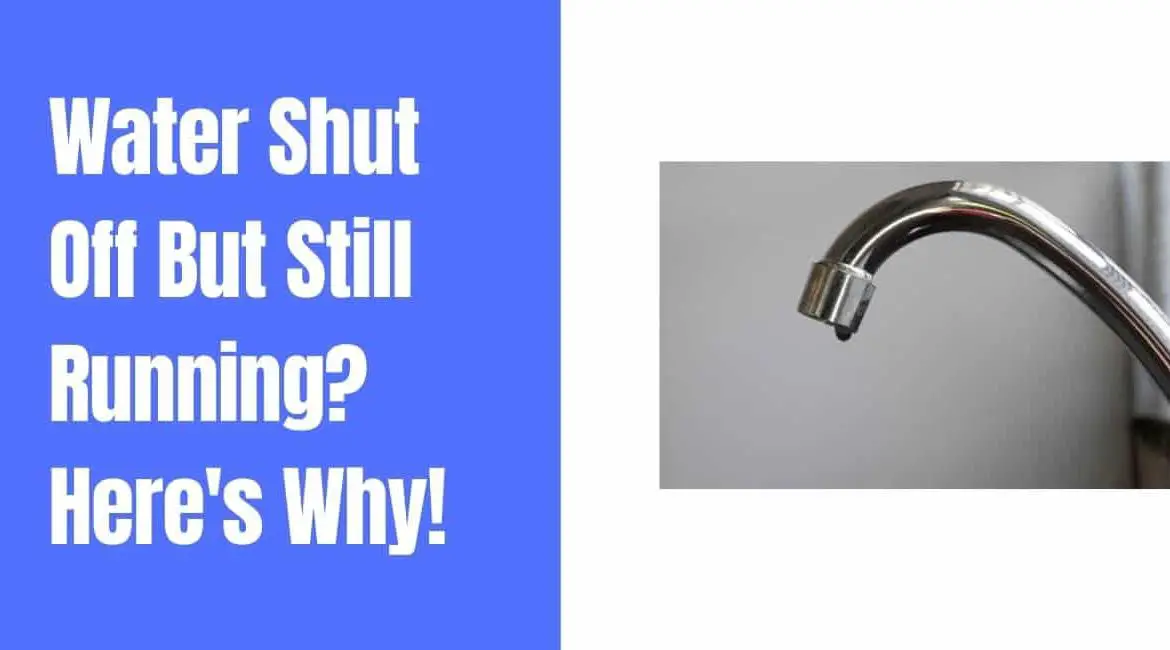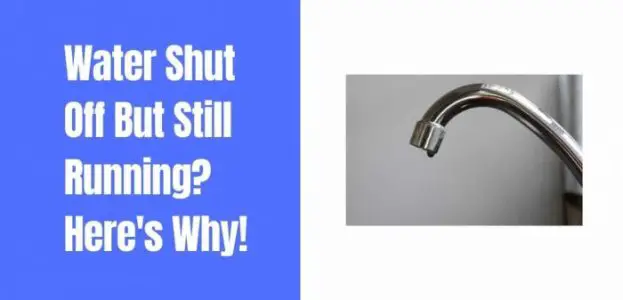If water shuts off but still running, the first action that you need to take is to check whether you have completely shut the main’s valve or the faucet’s handle. If both are shut off completely and there is still a thin or thick flow, it is time to probe further.
Turning off the main valve means turning off the water flow to your home. Once it is off, you would require the water meter, too, to stop running. However, at times, this does not happen.
Thus, your mind raises a question, “Why the water meter is still flowing or the faucet is still dripping?” It seems mysterious to many homeowners but this unwanted effect of leaking is due to a plumbing issue. Let’s understand more about it in this post along with some effective ways to fix it.
Table of Contents
- So, What Causes Water Shut Off But Still Running?
- Conclusion
So, What Causes Water Shut Off But Still Running?
Common Causes of Faucet Turned Off but Water Still Running
There can be a few covert reasons why your faucet is leaking or dripping despite shutting it off. One of these reasons is a hidden leak in the walls or running toilet when not in use. Such leaks can end up using water even if the main valve of the water meter is in the off position.
If the faucet is not turning off or trickles from the handle’s spout even when it is in the off mode, the most common cause is perhaps a faulty stem or cartridge. Present within a faucet valve housing, these components function as shut-off valves.
They are plastic and rubber parts that shut off the faucet by closing over the opening to stop the flow. However, they are susceptible to wear due to regular use, which can then result in leakage.
Whenever you turn the faucet off, its components namely the washers made up of plastic or rubber compress across an aperture to stop the flow. Years of usage shrinks their size until they cease to conceal the entire opening. When worn, these washers lead to dripping and running faucets. In this case, replacing them is the only option left for you.
There are also faucets without washers, which are cartridges, ball, and disc-style faucets, containing several parts made up of metal and plastic. Even they are vulnerable to wear and corrosion. They are likely to support the accumulation of mineral deposits that keep them away from sealing.
At times, even a corroded valve set can be the culprit due to the accumulation of residues. If the dripping occurs only at some fixed time or during specific times during the day, the reason is generally water pressure.
In short, dripping or running water even when faucets are closed well is the result of the damaged internal components or water pressure.
Difference Between Running and Leaking
You may already know the clear difference between running and leaking. However, many people perceive running and leaking as similar issues. The fact is that they both tend to differ significantly.
Leaky faucets tend to trickle at a slower pace while running ones possess a more continuous flow. Upon visualizing a leaking faucet, you would imagine a consistent trickle or a persistent stream in mind. However, at times, leaking faucets may remain unnoticed for some period, while running ones are instantly noticeable.
If you think that your issue is only a leak, consider verifying it by performing a small test. Ensure that the sink is dry, place a paper towel on it but just below the suspected faucet, and just keep it for some hours. If the paper towel has become wet, it means your suspicion about leaking is true.
At times, both leaking and running issues may be attributed to a couple of faulty parts. A new washer is required for the handle stem or the stem itself needs to be replaced.
Common Causes of Flow Despite Valve Shut Well
In this case, often the valve is the main culprit resulting in a nonstop flow. It has either corroded or worn out. Before you know how to fix this issue, it is important to know about the valve’s location and type.
Location
While houses that are a few decades old tend to have more than two or three valves, new residential structures usually come with two to three water line valves.
In the case of two valves, one is surrounding the water meter’s side and the other is just before the line meets the meter. The third one, if present, is usually installed on the street that only a technician can fix if it is worn or damaged.
It is only the first two valves that you shut off to stop the water flow to the house. In the case of an old house, the problem of water running despite turning off the main valve is likely to be due to leakage in specific fixtures.
These fixtures can be toilets, heaters, faucets, or washing machines, as valves are affixed to each fixture in an old home. Usually, the main water valves are present underground or in the basement. It may be even inside your home.
Type
Houses can have a globe, ball, or gate valves installed for water supply. A globe valve comes with a handle that features a nozzle with a seal at its bottom. Upon closing it, the nozzle goes down to stop the water flow.
A ball valve is the easiest one to use; it often functions as the main valve. It comes with a lever handle that allows or stops the flow immediately with only a slight turn. A gate valve features a round handle to turn the flow on or off completely in the pipes. It is not meant for controlling the flow.
Solutions to Faucet Water Shut Off But Still Running
Start by checking that the faucets are fully closed. Homeowners usually forget to close both sides fully in case of a dual-handled faucet or triple-handed faucet just over the bathtub. The angled handles tend to turn away from the jet to stop the flow. In the case of a knob-style handle, you need to rotate it clockwise to turn the water flow off.
If the issue of dripping is still there
The culprits are likely to be bad washers that you should now replace. Before calling a technician or a plumber, consider performing the following steps to ensure that an internal component of a faucet is damaged if you are a DIY fan:
- Start by shutting off all sources from where water is likely to come to your sink’s faucet. For this, find the valve beneath the sink and turn it off. In its absence, turn off the main water supply. If you do not perform this step and start repairing, you may end up facing a bigger flooding issue. Also, ensure that no water is dripping from your faucet by spinning its handle once the water supply has been stopped.
- Now, cover the drain for safe handling of the faucet and disassemble the sink.
- Remove the handles.
- Find online or in the manual about how to detach the valve’s stem or cartridge and perform the same.
- Check the rubber washers, rings, and other parts. If they look worn out or corroded, it is time to replace them.
- If you find mineral or water deposits on the faucet parts, soak them in vinegar only if they are made up of plastic. This is because vinegar easily deteriorates the rubber parts.
If the parts are not corroded or vinegar cleansing is done, reassemble them as instructed in the manual or online tutoring. Now, check for the dripping issue. If it persists, you should call a plumber.
Solutions To Water Keeps Running After Main Shut Off (Valve Issue)
Open all fixtures to see if the water is dripping from anywhere else and flush toilets. The water in the heater will come out from the fixtures. Open the main valve in the basement and allow it to drain. If the water does not stop quickly, it indicates a bad valve.
In most cases, the main culprit is a loose or missing rubber washer or gasket. This gasket covers the valve’s bottom to keep leakage at bay. Here, you can either fix or replace the gasket. For fixing the gasket, perform the following steps:
- With the assurance of no high pressure while fixing, start by re-opening the valve and close it in just a single turn to reduce the amount of flow.
- Use the wrench to hold the valve’s body to keep the pipeline straining at bay.
- Unscrew the valve’s guts and look for any debris at the bottom. If damaged, simply replace the valve.
- Remove the gasket and clean it using a dry cloth.
- Put it back and grease it. Affix it with thread seal tape.
- If the issue is the stem’s loose packing nut, use the wrench and grip it tighter to prevent leakage.
- Test the valve to see if dripping or leakage has gone.
Conclusion
The water shut off but the still running issue is due to a faulty or worn part due to frequent use over a period. You can close the valve or faucet completely or tightly, and then consider checking its parts for fixing the damaged ones or replacing them.
If you enjoy reading this article be sure to check why faucet turns on by itself.


